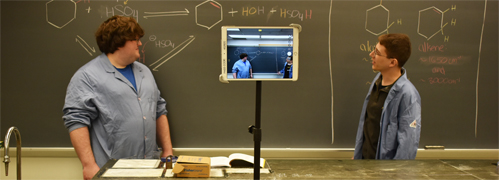Transition to online instruction
2020-03-31
Writer(s): Steve Scherer

Photo caption: Graduate students John Gulliver (Arun Ghosh Lab) and Damien Dobson (David Thompson Lab) maintain social-distancing and use an iPad to record CHM 255 Organic Chemistry lab in Brown Laboratory. Nearly 400 students, primarily life science majors, are taking the course this spring. Students who team-teach labs maintain social-distancing.
Because of the COVID-19 crisis, Purdue courses are being delivered remotely for the remainder of the Spring 2020 semester. The quick transition to online delivery has presented challenges for Chemistry faculty and students. But all seem to be adapting.
Dor Ben-Amotz, distinguished professor of physical chemistry and a 2012 Murphy Teaching Award winner, is teaching a course (CHM 372 Physical Chemistry) with 130 students enrolled.
He is live-streaming lectures that are also recorded for students who cannot be there in-person.
“I feel it is very important to continue offering students something resembling a live and direct communication experience. So far things have gone smoothly, although less than half the class has been logging in for the live Webex broadcast,” Ben-Amotz noted. Watch one of his lectures
Suzanne Bart, professor of inorganic chemistry and associate head of graduate education, is teaching a graduate course (CHM 647 Transition Metal and Organometallic Chemistry) and is offering asynchronous lectures, handouts, and problems sets posted on her Blackboard page so her students can work around their other classes and TA assignments.
“It also works better for my schedule, as my children are home with me now. I can make the recordings when I have time without them, instead of being locked down to specific lecture times like during the semester,” she explained.
“The most difficult part of online classes is that during a lecture if something is unclear you cannot ask right away,” said Alyssa Lambrecht, a senior undergraduate student who is taking three chemistry courses online at home.
With that lost interactivity, virtual office hours have become very important for instructors.
Jean Chmielewski, Alice Watson Kramer Distinguished Professor of Organic Chemistry/Chemical Biology and 2010 Murphy Teaching Award winner, is teaching a course (CHM 25500 Organic Chemistry) with 135 students.
“I have set up Webex for my office hour, and my head TA has also used Webex for his office hours and our weekly recitation. So far so good!” she said.
“I also have held two office hours with Webex. In addition, I am part of a GroupMe forum devoted to my class that allows me to chat with the students interactively,” added Mark Lipton, associate professor of organic chemistry/chemical biology and a 2018 Murphy Teaching Award winner who is teaching a course (CHM 26605 Organic Chemistry) with 80 students.
“We can never fully replace face-to-face interaction, especially for lab teaching experiments where students really need to interact with lab materials and instruments to learn proper laboratory skills,” explained Jonathan Rienstra-Kiracofe, an associate professor of practice, who is teaching two courses. (CHM 12600 General Chemistry II and HONR-39900 The Nuclear Age)
He says for his lab and others in the department, graduate TAs and the Prep Lab (see photo above) have made short videos completing various components of lab experiments, showing the process of performing the experiment and collecting the data.
For Marcy Towns, professor of chemical education and a 2013 Murphy Teaching Award winner who is teaching a General Chemistry course (CHM 11200) with an enrollment of more than 700 students, leaning on existing technology is driving her class lab experience forward.
“Fortunately, we were already using an online laboratory manual through Bluedoor labs thus the transition has been seamless, there's no transition to a different technology for the students and that has been a blessing for them,” she explained.
In her very large lecture class, Towns identified a couple of students who live in rural Indiana and did not have sufficient Wi-Fi to complete their coursework online. She used the Provost’s office to help solve that issue.
Paul Wenthold, an associate professor of physical/organic chemistry & mass spectrometry and associate head of teaching and undergraduate education, is teaching an organic chemistry course (CHM 26200 - mostly for chemical engineers) with a 160-student enrollment. He says he really does miss interaction with his students and has broken his lectures into 15-minute videos.
“I have tried to discourage students from binge-watching like a TV show. But in the end, students will do what they feel is best for themselves, and, as instructors, we can't change that. I just hope I can give them enough resources to learn and succeed,” he added.
Ashley Varney, a senior undergraduate student and teaching assistant, says, "So far, my professors and TAs have been very communicative, and I know exactly what is expected of me. As a TA for CHM 112, I have also had good luck with voicing over PowerPoints as a way to present my recitations.”
Jacob Brejcha, a junior undergraduate student who is taking three chemistry courses from home, added, “Online instruction cannot match the benefit of in-class instruction. Nevertheless, I feel like my chemistry professors have done an admirable job transitioning my classes to purely online formats. They have heeded students’ concerns and have tried to keep the classes as normal as possible.”